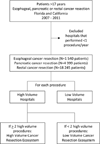Characterizing the role of a high-volume cancer resection ecosystem on low-volume, high-quality surgical care
- PMID: 27524432
- PMCID: PMC5105905
- DOI: 10.1016/j.surg.2016.07.002
Characterizing the role of a high-volume cancer resection ecosystem on low-volume, high-quality surgical care
Abstract
Background: Our objective was to determine the hospital resources required for low-volume, high-quality care at high-volume cancer resection centers.
Methods: Patients who underwent esophageal, pancreatic, and rectal resection for malignancy were identified using Healthcare Cost and Utilization Project State Inpatient Database (Florida and California) between 2007 and 2011. Annual case volume by procedure was used to identify high- and low-volume centers. Hospital data were obtained from the American Hospital Association Annual Survey Database. Procedure risk-adjusted mortality was calculated for each hospital using multilevel, mixed-effects models.
Results: A total of 24,784 patients from 302 hospitals met the inclusion criteria. Of these, 13 hospitals were classified as having a high-volume, oncologic resection ecosystem by being a high-volume hospital for ≥2 studied procedures. A total of 11 of 31 studied hospital factors were strongly associated with hospitals that performed a high volume of cancer resections and were used to develop the High Volume Ecosystem for Oncologic Resections (HIVE-OR) score. At low-volume centers, increasing HIVE-OR score resulted in decreased mortality for rectal cancer resection (P = .038). HIVE-OR was not related to risk-adjusted mortality for esophagectomy (P = .421) or pancreatectomy (P = .413) at low-volume centers.
Conclusion: Our study found that in some settings, low-volume, high-quality cancer surgical care can be explained by having a high-volume ecosystem.
Copyright © 2016 Elsevier Inc. All rights reserved.
Figures




Comment in
-
Discussion.Surgery. 2016 Oct;160(4):848-849. doi: 10.1016/j.surg.2016.07.006. Epub 2016 Aug 11. Surgery. 2016. PMID: 27524433 No abstract available.
Similar articles
-
Hospital procedure volume should not be used as a measure of surgical quality.Ann Surg. 2012 Oct;256(4):606-15. doi: 10.1097/SLA.0b013e31826b4be6. Ann Surg. 2012. PMID: 22964735
-
Hospital teaching status and outcomes of complex surgical procedures in the United States.Arch Surg. 2004 Feb;139(2):137-41. doi: 10.1001/archsurg.139.2.137. Arch Surg. 2004. PMID: 14769569
-
A decade analysis of trends and outcomes of partial versus total esophagectomy in the United States.Ann Surg. 2013 Sep;258(3):450-8. doi: 10.1097/SLA.0b013e3182a1b11d. Ann Surg. 2013. PMID: 24022437
-
Centralizing Esophagectomy to Improve Outcomes and Enhance Clinical Research: Invited Expert Review.Ann Thorac Surg. 2018 Sep;106(3):916-923. doi: 10.1016/j.athoracsur.2018.04.004. Epub 2018 May 5. Ann Thorac Surg. 2018. PMID: 29738757 Review.
-
The volume-outcome relationship: from Luft to Leapfrog.Ann Thorac Surg. 2003 Mar;75(3):1048-58. doi: 10.1016/s0003-4975(02)04308-4. Ann Thorac Surg. 2003. PMID: 12645752 Review.
Cited by
-
Seeing the forest beyond the trees: Predicting survival in burn patients with machine learning.Am J Surg. 2018 Mar;215(3):411-416. doi: 10.1016/j.amjsurg.2017.10.027. Epub 2017 Nov 7. Am J Surg. 2018. PMID: 29126594 Free PMC article.
-
Regionalization of thoracic surgery improves short-term cancer esophagectomy outcomes.J Thorac Dis. 2019 May;11(5):1867-1878. doi: 10.21037/jtd.2019.05.30. J Thorac Dis. 2019. PMID: 31285879 Free PMC article.
-
Chemoradiotherapy With or Without Surgery for Esophageal Squamous Cancer According to Hospital Volume.JCO Glob Oncol. 2020 Jun;6:828-836. doi: 10.1200/JGO.19.00360. JCO Glob Oncol. 2020. PMID: 32552112 Free PMC article.
-
Prophylactic Pancreatectomies Carry Prohibitive Mortality at Low-Volume Centers: A California Cancer Registry Study.World J Surg. 2019 Sep;43(9):2290-2299. doi: 10.1007/s00268-019-05019-6. World J Surg. 2019. PMID: 31062057 Free PMC article.
References
-
- Luft HS, Bunker JP, Enthoven AC. Should operations be regionalized? the empirical relation between surgical volume and mortality. N Engl J Med. 1979;301:1364–1369. - PubMed
-
- Birkmeyer JD, Siewers AE, Finlayson EV, Stukel TA, Lucas FL, Batista I, et al. Hospital volume and surgical mortality in the united states. N Engl J Med. 2002;346:1128–1137. - PubMed
-
- Karthikesalingam A, Hinchliffe RJ, Loftus IM, Thompson MM, Holt PJ. Volume-outcome relationships in vascular surgery: The current status. J Endovasc Ther. 2010;17:356–365. - PubMed
-
- Faiz O, Brown T, Bottle A, Burns EM, Darzi AW, Aylin P. Impact of hospital institutional volume on postoperative mortality after major emergency colorectal surgery in english national health service trusts, 2001 to 2005. Dis Colon Rectum. 2010;53:393–401. - PubMed
-
- Finlayson EV, Goodney PP, Birkmeyer JD. Hospital volume and operative mortality in cancer surgery: A national study. Archives of Surgery. 2003;138:721–725. - PubMed
MeSH terms
Grants and funding
LinkOut - more resources
Full Text Sources
Other Literature Sources
Miscellaneous

